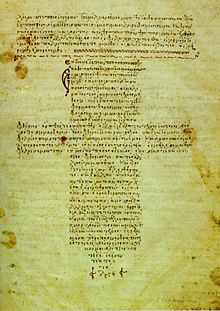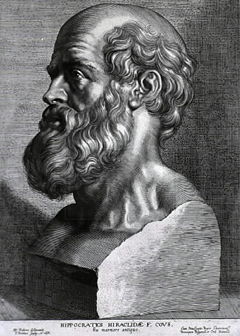Hippocratic Oath

The Hippocratic Oath is an oath traditionally taken by physicians pertaining to the ethical practice of medicine. It is widely believed that the oath was written by Hippocrates, the father of medicine, in the 4th century BC, or by one of his students. It is thus usually included in the Hippocratic Corpus. Classical scholar Ludwig Edelstein proposed that the oath was written by Pythagoreans, a theory that has been questioned due to the lack of evidence for a school of Pythagorean medicine. Although mostly of historical and traditional value, the oath is considered a rite of passage for practitioners of medicine, although it is not obligatory and no longer taken up by all physicians.
Contents |
The original oath
In the original Greek, it read:
| “ | Ὄμνυμι Ἀπόλλωνα ἰητρὸν, καὶ Ἀσκληπιὸν, καὶ Ὑγείαν, καὶ Πανάκειαν, καὶ θεοὺς πάντας τε καὶ πάσας, ἵστορας ποιεύμενος, ἐπιτελέα ποιήσειν κατὰ δύναμιν καὶ κρίσιν ἐμὴν ὅρκον τόνδε καὶ ξυγγραφὴν τήνδε.
Ἡγήσασθαι μὲν τὸν διδάξαντά με τὴν τέχνην ταύτην ἴσα γενέτῃσιν ἐμοῖσι, καὶ βίου κοινώσασθαι, καὶ χρεῶν χρηίζοντι μετάδοσιν ποιήσασθαι, καὶ γένος τὸ ἐξ ωὐτέου ἀδελφοῖς ἴσον ἐπικρινέειν ἄῤῥεσι, καὶ διδάξειν τὴν τέχνην ταύτην, ἢν χρηίζωσι μανθάνειν, ἄνευ μισθοῦ καὶ ξυγγραφῆς, παραγγελίης τε καὶ ἀκροήσιος καὶ τῆς λοιπῆς ἁπάσης μαθήσιος μετάδοσιν ποιήσασθαι υἱοῖσί τε ἐμοῖσι, καὶ τοῖσι τοῦ ἐμὲ διδάξαντος, καὶ μαθηταῖσι συγγεγραμμένοισί τε καὶ ὡρκισμένοις νόμῳ ἰητρικῷ, ἄλλῳ δὲ οὐδενί. Διαιτήμασί τε χρήσομαι ἐπ' ὠφελείῃ καμνόντων κατὰ δύναμιν καὶ κρίσιν ἐμὴν, ἐπὶ δηλήσει δὲ καὶ ἀδικίῃ εἴρξειν. Οὐ δώσω δὲ οὐδὲ φάρμακον οὐδενὶ αἰτηθεὶς θανάσιμον, οὐδὲ ὑφηγήσομαι ξυμβουλίην τοιήνδε. Ὁμοίως δὲ οὐδὲ γυναικὶ πεσσὸν φθόριον δώσω. Ἁγνῶς δὲ καὶ ὁσίως διατηρήσω βίον τὸν ἐμὸν καὶ τέχνην τὴν ἐμήν. Οὐ τεμέω δὲ οὐδὲ μὴν λιθιῶντας, ἐκχωρήσω δὲ ἐργάτῃσιν ἀνδράσι πρήξιος τῆσδε. Ἐς οἰκίας δὲ ὁκόσας ἂν ἐσίω, ἐσελεύσομαι ἐπ' ὠφελείῃ καμνόντων, ἐκτὸς ἐὼν πάσης ἀδικίης ἑκουσίης καὶ φθορίης, τῆς τε ἄλλης καὶ ἀφροδισίων ἔργων ἐπί τε γυναικείων σωμάτων καὶ ἀνδρῴων, ἐλευθέρων τε καὶ δούλων. Ἃ δ' ἂν ἐν θεραπείῃ ἢ ἴδω, ἢ ἀκούσω, ἢ καὶ ἄνευ θεραπηίης κατὰ βίον ἀνθρώπων, ἃ μὴ χρή ποτε ἐκλαλέεσθαι ἔξω, σιγήσομαι, ἄῤῥητα ἡγεύμενος εἶναι τὰ τοιαῦτα. Ὅρκον μὲν οὖν μοι τόνδε ἐπιτελέα ποιέοντι, καὶ μὴ ξυγχέοντι, εἴη ἐπαύρασθαι καὶ βίου καὶ τέχνης δοξαζομένῳ παρὰ πᾶσιν ἀνθρώποις ἐς τὸν αἰεὶ χρόνον. παραβαίνοντι δὲ καὶ ἐπιορκοῦντι, τἀναντία τουτέων. |
” |
Original, translated into English:[1]
| “ | I swear by Apollo, Asclepius, Hygieia, and Panacea, and I take to witness all the gods, all the goddesses, to keep according to my ability and my judgment, the following Oath.
To consider dear to me, as my parents, him who taught me this art; to live in common with him and, if necessary, to share my goods with him; To look upon his children as my own brothers, to teach them this art. I will prescribe regimens for the good of my patients according to my ability and my judgment and never do harm to anyone. I will not give a lethal drug to anyone if I am asked, nor will I advise such a plan; and similarly I will not give a woman a pessary to cause an abortion. But I will preserve the purity of my life and my arts. I will not cut for stone, even for patients in whom the disease is manifest; I will leave this operation to be performed by practitioners, specialists in this art. In every house where I come I will enter only for the good of my patients, keeping myself far from all intentional ill-doing and all seduction and especially from the pleasures of love with women or with men, be they free or slaves. All that may come to my knowledge in the exercise of my profession or in daily commerce with men, which ought not to be spread abroad, I will keep secret and will never reveal. If I keep this oath faithfully, may I enjoy my life and practice my art, respected by all men and in all times; but if I swerve from it or violate it, may the reverse be my lot. |
” |
Modern relevance

Several parts of the oath have been removed or re-shaped over the years in various countries, schools, and societies as the social, religious, and political importance of medicine has changed. Most schools administer some form of oath, but the great majority no longer use the ancient version, which forbade general practitioners from surgery, abortion, and euthanasia. Also missing from the ancient Oath and from many modern versions are the complex ethical issues that face the modern physician. It has been suggested that a similar oath should be undertaken by scientists, a Hippocratic Oath for Scientists.
Changed portions of the oath:
- To teach medicine to the sons of my teacher. Many medical schools have given and continue to give preferential consideration to the children of physicians.
- To practice and prescribe to the best of my ability for the good of my patients, and to try to avoid harming them. This beneficial intention is the purpose of the physician. However, this item is still invoked in the modern discussions of euthanasia.
- Never to do deliberate harm to anyone for anyone else's interest. Physician organizations in most countries have strongly denounced physician participation in legal executions. However, in a small number of cases, most notably Oregon[3], Washington, and the Netherlands[4], a doctor can prescribe euthanasia with the patient's consent.
- To avoid violating the morals of my community. Many licensing agencies will revoke a physician's license for offending the morals of the community ("moral turpitude").
- To avoid attempting to do things that other specialists can do better. The "stones" referred to are kidney stones or bladder stones, removal of which was judged too menial for physicians, and therefore was left for barbers (the forerunners of modern surgeons). Surgery was not recognized as a specialty at that time. This sentence is now interpreted as acknowledging that it is impossible for any single physician to maintain expertise in all areas. It also highlights the different historical origins of the surgeon and the physician.
- To keep the good of the patient as the highest priority. There may be other conflicting 'good purposes,' such as community welfare, conserving economic resources, supporting the criminal justice system, or simply making money for the physician or his employer that provide recurring challenges to physicians.
Modern versions and alternatives

A widely used modern version of the traditional oath was penned by Dr. Louis Lasagna, former Dean of the Sackler School of Graduate Biomedical Sciences of Tufts University.[5]
In the 1970s, cultural and social forces induced many American medical schools to abandon the Hippocratic Oath as part of graduation ceremonies, usually substituting a version modified to something considered more politically up to date, or an alternate pledge like the Oath or Prayer of Maimonides.
The Hippocratic Oath has been updated by the Declaration of Geneva. In the United Kingdom, the General Medical Council provides clear modern guidance in the form of its Duties of a Doctor[6] and Good Medical Practice[7] statements.
See also
- Declaration of Helsinki
- Geneva convention
- Hippocrates
- Hospital Corpsman Pledge
- Medical ethics
- Nightingale Pledge
- Nuremberg code
- The White Coat Ceremony
- Primum non nocere
- Oath of Asaph
- Oath of the Hindu physician
- Seventeen Rules of Enjuin
- Sun Simiao
- Phil Gingrey
Footnotes
-
1 cf. L.R. Farnell, Greek Hero Cults and Ideas of Immortality, Chapter 10, "The Cult of Asklepios" (pp.234-279), p.269: "The famous Hippocratean oath may not be an authentic deliverance of the great master, but is an ancient formula current in his school."
-
2 Owsei Temkin, "On Second Thought," in "On Second Thought" and Other Essays in the History of Medicine, Baltimore: Johns Hopkins University Press, 2002.
References
- ↑ Hippocrates | The Oath - National Institutes of Health page about the Hippocratic oath
- ↑ National Library of Medicine 2006
- ↑ Oregon’s Death with Dignity law
- ↑ International Task Force - Euthanasia in the Netherlands
- ↑ Lasagna, Louis (1964, broadcast March 27, 2001 to April 10, 2001). "Hippocratic Oath—Modern Version". WGBH Educational Foundation for PBS and NOVA Online: Survivor M.D.. Retrieved on 2007-11-07.
- ↑ "Good Medical Practice: The duties of a doctor registered with the General Medical Council". General Medical Council (2006). Retrieved on 2007-11-05.
- ↑ "Good Medical Practice". General Medical Council (2006). Retrieved on 2007-11-05.
- The Hippocratic Oath - a BBC article about the oath
- The Hippocratic Oath Today: Meaningless Relic or Invaluable Moral Guide? - a PBS NOVA Online discussion with responses from doctors as well as 2 versions of the oath
- Lewis Richard Farnell, Greek Hero Cults and Ideas of Immortality, 1921.
- "Codes of Ethics: Some History" by Robert Baker, Union College in Perspectives on the Professions, Vol. 19, No. 1, Fall 1999 [1]
External links
- BBC - Hippocratic Oath
- Hippocratic Oath - Classical version
- Hippocratic Oath - Modern version
- Hippocratis jusiurandum - Image of a 1595 copy of the Hippocratic oath with side-by-side original Greek and Latin translation
- Hippocrates | The Oath - National Institutes of Health page about the Hippocratic oath
- [2]( Hippocratic Oath, Video reenactment of the oath.)
- Tishchenko P. D. Resurrection of the Hippocratic Oath in Russia